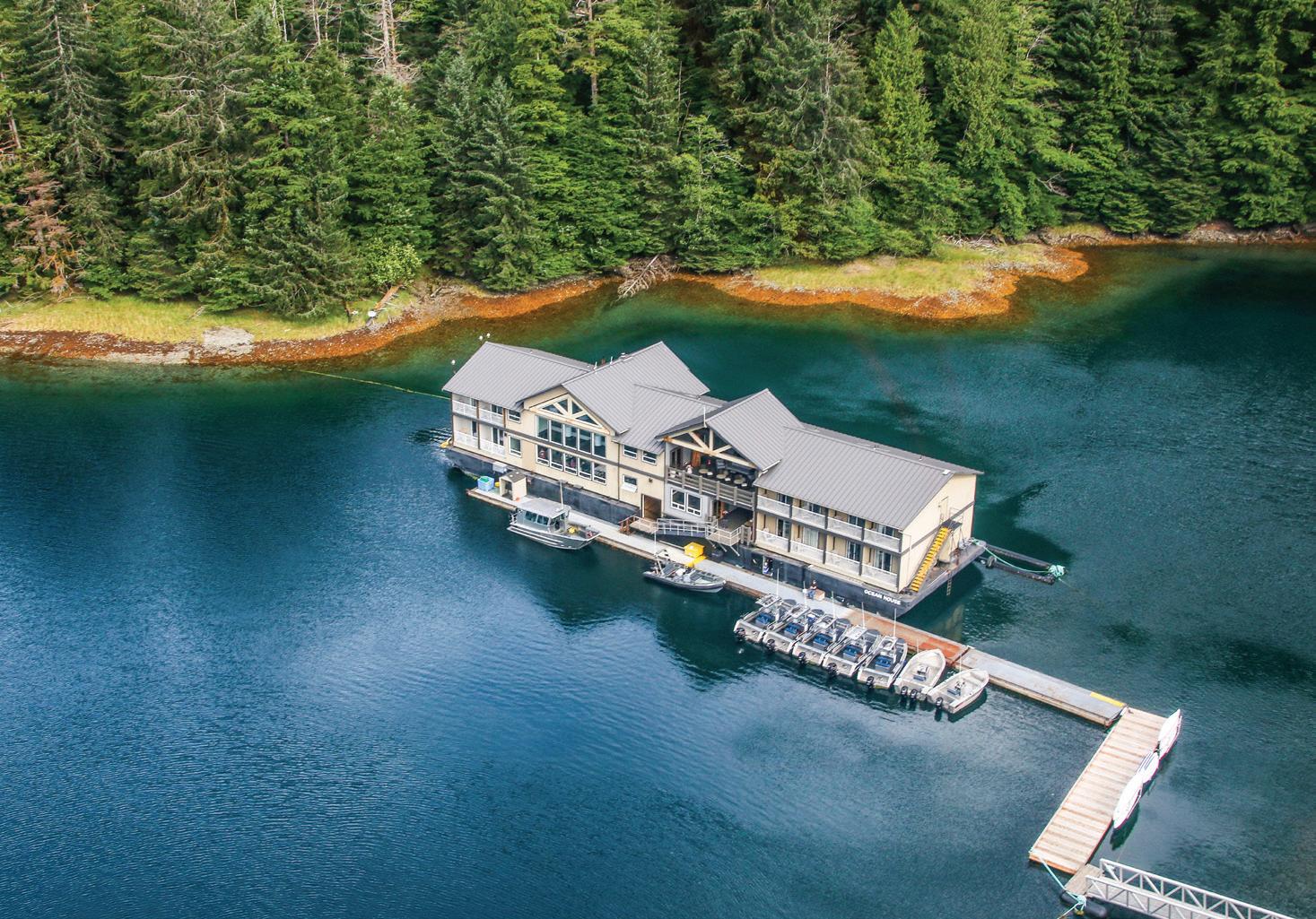
3 minute read
Afloat in Haida Culture
By Hans Tammemagi
A Zodiac carries us through a convoluted seascape of twisting bays and fjords, all enshrouded in an ephemeral mist. We see no clear cuts, no fish farms, no sign of humans. It is remote, soothing and totally captivating.
Arriving at a secluded cove, our guide Jaylene, a young Haida woman, leads us into a primal old-growth forest – rich, green, and soft, all carpeted in deep moss. Amongst the greenery, we find evidence of the abandoned village of Ts’aa.ahl. Skeletal totems are grim reminders of a once-vibrant community home to 37 houses and a population of about 500.

Ocean House at Tlaga Gawtlaas
©Hans Tammemagi
Now all is moss covered and decaying. A 12-metre totem, grey and weathered, still looms upright. “This pole is about 250 years old and was the house pole for a longhouse,” says Jaylene. I feel a chill for this is a spiritual place.
A day earlier, I had arrived at Sandspit Airport in Haida Gwaii and clambered aboard a 12-seater Sikorsky S-76 helicopter. We headed west soaring through mountain passes and along lush, remote valleys to a cove on northwest Moresby Island, part of the Haida Gwaii archipelago off the northern coast of British Columbia.

Local surfer and carver on the shores of Naikoon Provincial Park
©Northern BC Tourism/Marcus Paladino
As Ocean House came into view, it was breathtaking, an elegant two-storey resort floating like a mirage in a secluded cove. It is one of the most luxurious resorts in Haida Gwaii, and one of the most unusual. Built on a barge, it can be towed to any desired location. Formerly a high-end fishing lodge, Ocean House was extensively remodelled and upgraded in 2018. But I was not here to chase salmon. My goal was to immerse myself in Haida culture.
The lodge is comfortable, sophisticated and mobile. Ocean House was recently moved to near Old Massett, and may move again. Wherever it winds up, however, it will offer an exceptional immersive experience in Haida culture. Masks, paintings, photos and carvings offer guests a look at the traditions of the Haida First Nation, from art to music. We’re greeted by Jaylene who sang a welcome song while beating her grandmother’s 70-year-old drum. Though I didn’t understand the Haida lyrics, I was captivated.

Forest near ancient Haida village site Kiusta
©Destination BC/Grant Harder
Soon after, our group clambered aboard two boats and motored into the western archipelago. The unique flora and fauna – here, the waters teem with grey orca and humpback whales, salmon, seals, sea lions, porpoises and marine birds – have helped Haida Gwaii earn the name, “Galápagos of the North.”
At an isolated bay, Jaylene points to a cedar tree with a strip of bark removed. “My ancestors harvested cedar sustainably here for centuries,” she explains. Enveloped in the deep, dusky greenery, I think I glimpse trolls and orcs in the forest around us and understand why the Haida believe in supernatural creatures.

A humpback whale diving
©Destination BC/Grant Harder
That evening, we sit down to a dinner at the lodge – an amuse bouche of scallops, followed by a main course of salmon with razor clam fritters, and finally, an elegant panna cotta.
Chef Brodie Swanson loves to prepare fresh-caught seafood like salmon, halibut and his favourite, razor clams. He learned his culinary skills the Haida way. His parents and elders encouraged him and he received extensive mentoring.
Next morning, I meet the artist-in-residence, Marilyn McKee, a Haida of the Eagle and Hummingbird clans, also a jeweller and painter. Surrounded by jewellery tools, masks and a splendid white button blanket, she patiently teaches me how to hammer and bend a piece of copper into a bracelet.

A Haida totem pole in front of a cedar longhouse
On the last afternoon, while others swim and teeter on stand-up paddleboards, I paddle a kayak down the sound. Soon, islands hide the lodge and I’m alone in soothing solitude, floating in this mystical place of legends, spirits and supernatural creatures.
Later, as we depart, I look down from the helicopter at the misty inlets and lush hills and think this is a place every Canadian should visit.










